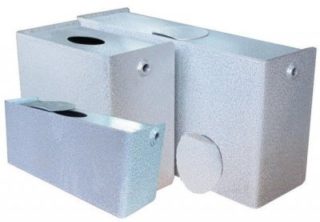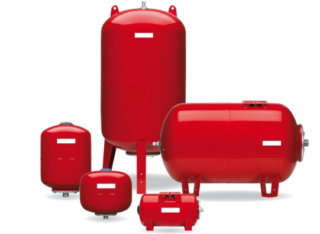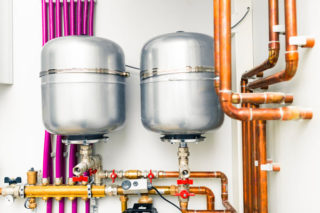When heated, the volume of liquid always increases. In order to compensate for these temperature surges in the heating system, expansion tanks must be installed. For every 10 degrees, the volume can grow up to 0.3%. The fluid is incompressible, so the excess has nowhere to go. It will enter the expansion tank until it cools completely. If excess water is removed, the remaining empty space after cooling the circuit will be filled with air. Because of this, air jams form, which can lead to blockage of all heating. Expansion vessel can solve this problem. In order for the heating to function correctly, you need to know how to calculate the expansion tank for heating.
Selection of expansion tank for various types of heating systems
When installing heating equipment, you can use open and closed expansion tanks.
Open
Open type devices are designed for use in a natural circulation heating system. The tank is an open tank, a connection is equipped at its bottom. The tank itself is located at the highest point. This causes inconvenience to use. The tank must be installed in the attic, on the roof of the house, in order to control the liquid level, you need to constantly go up to the attic.
Open expansion vessels must be sealed with thermal insulation. It is made of sheet steel. A hatch for inspection should be made on top of the device. The maximum fluid level limit will be controlled by an overflow pipe that goes outside.
Open expansion tanks perform several functions:
- maintain the volume of the coolant during temperature fluctuations;
- restore fluid volume in the event of a leak;
- when the system overflows, excess water is dumped into the sewer;
- limit hydraulic pressure;
- remove air from the system.
The disadvantage of devices is their large size. They are prone to internal corrosion of heating appliances. Because of these shortcomings, open-type containers are very rarely used in heating systems.
Closed
Closed expansion tanks - the best option for heating with natural and forced circulation. Thanks to the appearance of such devices, it became possible to operate a heating system without contact with the atmosphere. During the circulation of the coolant will not be released impurities, due to which corrosion is formed.
The use of such a system extends the life of pipes and equipment. The closed heating circuit can operate under high pressure. In this case, additional replenishment will not be necessary.
Closed expansion tanks are equipped in boiler rooms. They can be used all year round without fear of freezing.
Requirements when choosing an expansion tank
The expansion tank in the heating system is one of the important elements that affects the quality and safety of work. Therefore, when choosing, you need to pay attention to certain points:
- It is recommended that you select a device with a safety valve. They are equipped with most modern tanks. If it is not, it is better to purchase separately. If the valve will often operate, then the volume calculations are incorrect. To correct the situation, you can purchase additional equipment that is installed parallel to the old.
- The smallest capacity should be at least 10% of the total system volume.
- The design must be solid, without mechanical damage.
Experts do not recommend purchasing very cheap devices. It is better to give preference to trusted manufacturers. Only in this case will a long service life be guaranteed.
The quality of the equipment must be documented. It must comply with hygiene requirements, have international certificates.
Methods for calculating tank size
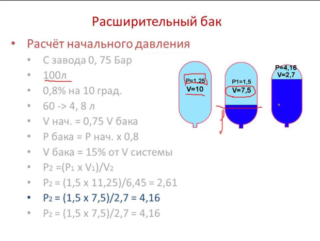 Calculation methods may vary depending on the heating system. For the closed type, it is recommended to use mathematical formulas. If an open heating system is used, the tank volume can be calculated using a simple algorithm.
Calculation methods may vary depending on the heating system. For the closed type, it is recommended to use mathematical formulas. If an open heating system is used, the tank volume can be calculated using a simple algorithm.
General selection method
The capacity volume can be selected at the rate of 10% of the total internal size of the heating complex.
Formula calculation
Most often, the method for calculating the volume of the expansion tank for closed-type heating is the formula: A = Bx / KwhereAT - heat carrier volume, WITH - parameters of thermal expansion of the coolant, TO - parameters of the effectiveness of the membrane tank.
Calculation of the volume of coolant
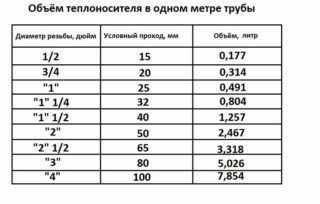 The procedure for calculating the volume of coolant is based on three methods.
The procedure for calculating the volume of coolant is based on three methods.
Geometric
Mathematical calculation is performed by summing all the elements. This will require:
- Capacity of the boiler, which is prescribed in the passport.
- The volume of water, which is calculated depending on the number of sections in the radiator. All information about the volume of one section is registered in the documentation with technical specifications.
- The amount of water in the pipeline is calculated by measuring all lengths.
All elements are added, as a result, the total volume of the coolant is obtained.
When filling the system
The most accurate calculation methods include filling the system with water. A water meter is used to control the volume. If it is not, you can drain the water into buckets and thus calculate the volume obtained.
Generalized method
For 1 kW of boiler heat capacity, 15 liters of the total system volume are taken. Depending on the types of heating appliances, the generalized method will have an updated modification.
If radiators are used, the amount of water should be at least 11 liters, in convectors - at least 7 liters. For a warm floor, the volume should be 18 liters.
In the technical passport of the equipment, the manufacturer prescribes the volume of the heat exchanger. The amount of water in the pipeline can be calculated independently. To do this, calculate their length and internal volume. All indicators, including the boiler, pipes and appliances, should be summarized. The result will be the total volume of the heating complex.
The consequences of incorrect calculations
If the volume of the expansion tank is calculated correctly, the pressure during operation will always be stable. All excess water that is formed during the expansion process will be collected in a special tank.
When the calculations are carried out incorrectly, constant pressure drops will be observed in the system. If in a closed heating system the excess hot water is not discharged anywhere, an accident will occur. Pipes may burst, joints may be depressurized.
Differential pressure in the system can provoke:
- shutdown of the entire heating system;
- freezing if the boiler stops in the winter.
If the tank volume is insufficient, the circuit needs to be replenished with water. Most often, this situation is faced by the owners of the boiler with an integrated tank.
It is recommended to purchase an expansion tank with a reserve by volume. If the stock is not included in the calculation, this will negatively affect the operation of the entire system.
In order for the entire area of the house to be completely heated, it is necessary to correctly calculate all the parameters of the equipment. Errors in the selection can lead to a complete failure of the heating system.
